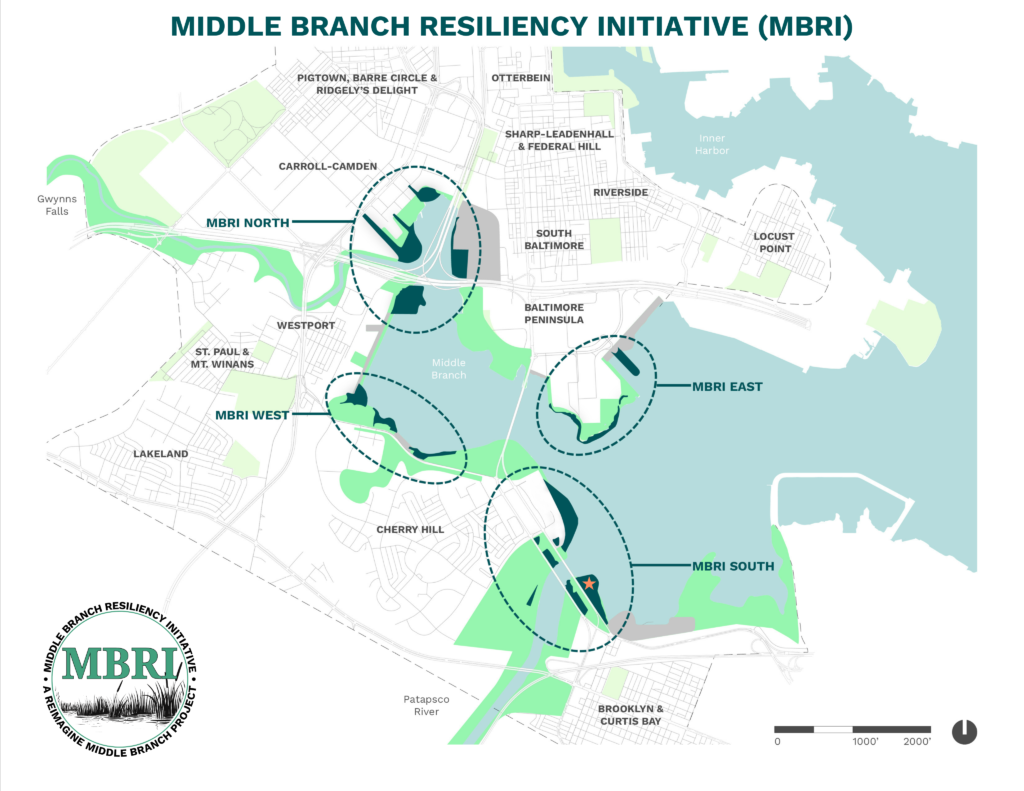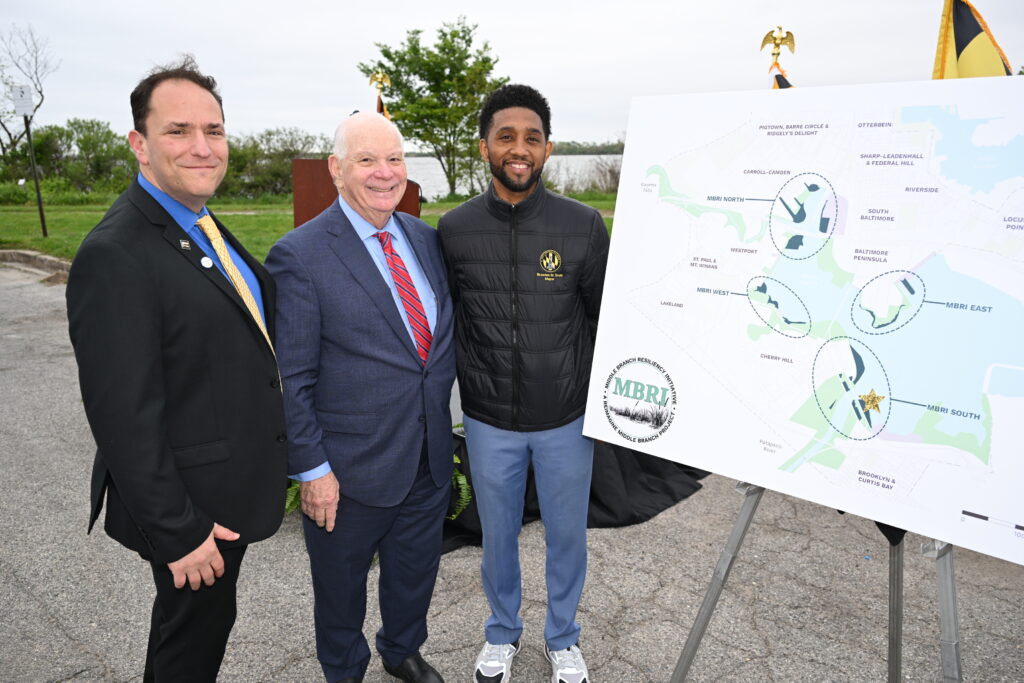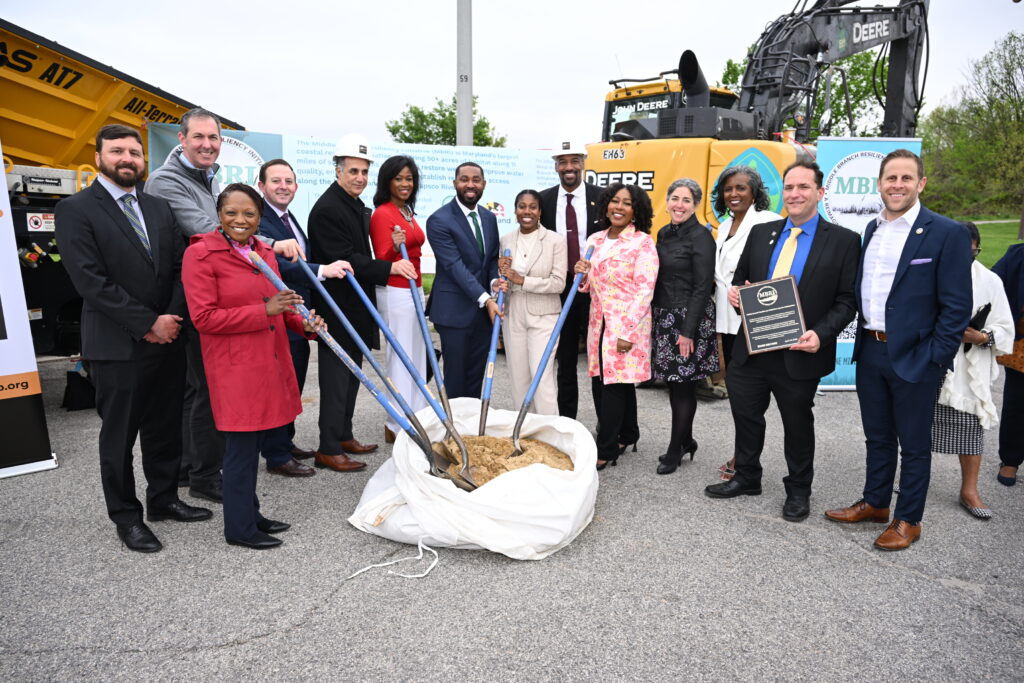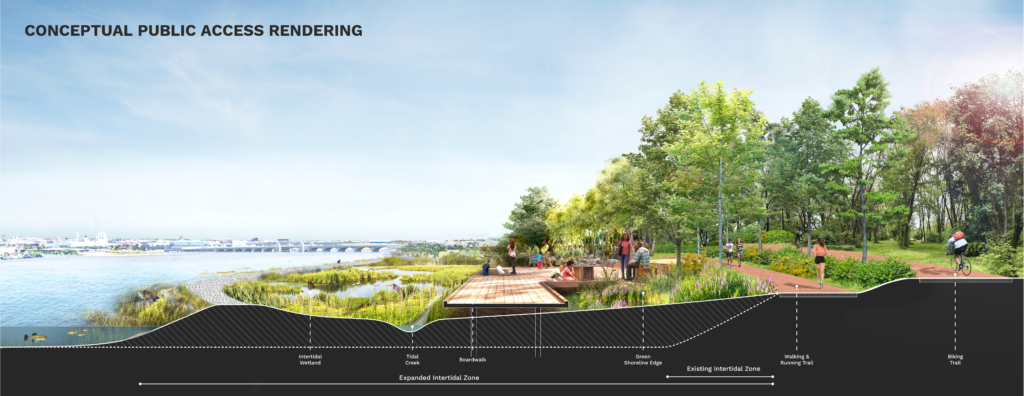Middle Branch Resiliency Initiative Wetland Restoration Project Launches in South Baltimore
Monumental watershed initiative kicks off with support from Federal, State, and Local elected and appointed officials and partners
(Baltimore, MD) – Senator Ben Cardin, Senator Chris Van Hollen’s Baltimore City Regional Director Elonna Jones, Congressman John Sarbanes, Congressman Kweisi Mfume’s Acting District Director Ray Conaway, Senate President Bill Ferguson, Comptroller Brooke Lierman’s Chief of Staff Rianna Matthews-Brown, Mayor Brandon M. Scott, Councilwoman Phylicia Porter’s Chief of Staff Ashia Caraway, and Baltimore County Executive John “Johnny O” Olszewski, Jr. joined community leaders, representatives of governmental agencies, the leadership of BGE, Medstar Harbor Hospital, and the South Baltimore Gateway Partnership (SBGP) to celebrate the commencement of the Middle Branch Resiliency Initiative (MBRI) as part of Reimagine Middle Branch. The Hanover Street Wetlands, approximately 10 acres in “MBRI South,” is the first living shoreline section to commence construction, representing one of many steps toward fulfilling Reimagine Middle Branch’s commitment to fostering equity by protecting and connecting South Baltimore’s shoreline and communities. Completion of the Hanover Street Wetlands section is anticipated in late 2025.
MBRI supports environmental justice goals by enhancing South Baltimore communities’ resilience and protecting critical infrastructure from coastal flooding, intense storm events, erosion, and sea level rise. These goals continue with improving public access to Baltimore city’s waterfront, including greenspace/water recreation and fishing, by restoring wetland habitat diversity and improving water quality. Concurrent, ongoing shoreline clean-up and maintenance efforts enhance the work of two Trash Wheels in removing debris from the Middle Branch, partnering with these wetland restoration efforts.
Beneficiaries are primarily concentrated in the jurisdictions of Baltimore City, Baltimore County, and Anne Arundel County. All told, MBRI benefits nearly 410,000 people, representing 21% of the total population of those three jurisdictions, though the impacts extend far beyond this to include improvements to water and environmental quality for all residents of the region and the overall health of the Chesapeake Bay.
The Middle Branch Resiliency Initiative was conceived of and will be implemented by SBGP and is made possible by support from local, state, and federal funding sources. At this time, a tremendous amount of nearly $67 million has been committed to this project. Current funding includes:
- $31.9 million in a FEMA grant under the Building Resilient Infrastructure and Communities (or BRIC) program, as a subaward from the Maryland Department of Emergency Management;
- $3.4 million from the National Fish and Wildlife Foundation’s National Coastal Resilience Fund;
- $3.5 million from Maryland Department of Natural Resources’ Chesapeake & Atlantic Coastal Bays Trust Fund;
- $5.1 million from Baltimore City’s Department of Public Works;
- $6.6 million from Baltimore County;
- $5.6 million from the National Oceanic and Atmospheric Agency’s (or NOAA’s) Transformational Habitat Restoration and Coastal Resilience Grants
- $10.8 million from Maryland’s Department of the Environment
“Today, we’re delivering on our commitment to bring environmental justice to South Baltimore. We are restoring not just the shoreline, but the community’s access to their own waterfront. And we’re doing this in partnership with dozens of local organizations, who are already busy removing trash, leading youth programs, and even paying anglers to catch invasive fish. This is how Baltimore’s waterfront thrives for generations – by working together,” said Brad Rogers, Executive Director of the South Baltimore Gateway Partnership.
“Rising sea levels, extreme weather events, and erosion are taking aim at our coastal ecosystems. The Middle Branch Resiliency Initiative (MBRI) is part of the incredible effort Maryland is leading to make coastal communities in Baltimore and across the state more resilient and more equitable. This community-led project will help reconnect South Baltimore communities to each other and to their waterways, which for two long have been separated through infrastructure and industrial use,” said Senator Cardin. “This is a model project that demonstrates that investments from Bipartisan Infrastructure Law and the Inflation Reduction Act, can advance several goals at once: restoring critical coastal habitats, advancing our commitment to environmental justice and protecting our communities from the impact of climate change.”
“The protection of our shorelines is not just an environmental responsibility, it’s also a safety imperative for coastal communities under threat from erosion and flooding,” said Senator Van Hollen. “Propelled by over $40 million in federal funding, the Middle Branch Resiliency Initiative will ultimately help restore over 50 acres of natural habitat – while providing waterfront access to communities who have long been cut off, including Brooklyn, Cherry Hill, Curtis Bay, and Westport and safeguarding South Baltimore neighborhoods from the effects of climate change. Today’s launch is an important milestone in our efforts to preserve the integrity of these beautiful waterfront areas for generations to come.”
“I have long supported the Middle Branch Resiliency Initiative’s work to improve infrastructure in a vibrant community and bolster the Chesapeake Bay’s environmental ecosystem,” said Congressman Sarbanes. “Today, we celebrate the official launch of MBRI with the groundbreaking of the Hanover Street Wetlands, the initiative’s first resiliency structure to help protect communities from the extreme effects of climate change. I look forward to seeing how this and all future Middle Branch projects will create more economic and recreational opportunities, advance environmental justice and connect more Marylanders to our beloved Chesapeake Bay.”
“The residents of Middle Branch and the surrounding communities know that climate change and its effects on our environment are real. The Middle Branch Resiliency Initiative is another example of how federal dollars are driving the effort to protect the Chesapeake Bay and combat the effects of climate change,” said Congressman Kweisi Mfume. “Three years ago, I fought to pass the Bipartisan Infrastructure Law. With a bulk of this project’s funding coming from that legislation, I am pleased to finally recognize the start of construction today,” he concluded.
“The Middle Branch Resilience Initiative is an essential project for our region and state. Leveraging federal, state, and local partnerships and dollars, this effort will revitalize the shoreline, protect the watershed and water-adjacent neighborhoods, and reconnect communities to the beauty of the Patapsco River,” said Comptroller Lierman, who has also served on the Middle Branch Advisory Committee. “This project, through collaborative work focused on climate resilience and equity, will reconnect South Baltimore neighborhoods and restore public access to an important piece of our geography. I am thrilled to have played a role in this project since its inception and excited to see this amazing progress.”
“The Middle Branch Resiliency Initiative is foundational to the transformation taking place through the broader Reimagine Middle Branch Plan,” said Senate President Bill Ferguson. “The nearly $15 million in State funding to help restore 11 miles of shoreline and reconnect surrounding neighborhoods with one of Baltimore’s most important assets, its waterfront, is just the first step in this multi-year commitment. Along with Delegates Clippinger, Lewis, and Edelson, we are proud to play a role in the Middle Branch’s revitalization.”
“Baltimore’s waterways are one of our biggest assets, and this transformational project is instrumental in building a more sustainable future for our city and the entire Baltimore region,” said Mayor Brandon M. Scott. “Baltimore is proud to be making a significant investment, through both our Recreation & Parks Department and with $5.1 million through our Department of Public Works’ Stormwater Enterprise Fund to help move this regional teamwork forward. Not only does the Middle Branch Resiliency Initiative align with our City’s Disaster Preparedness and Planning Project (DP3) goals for climate resilience, but it will protect our waterways, help make our communities healthier, and strengthen all of South Baltimore.”
“As representative of South Baltimore, I am proud to champion the Middle Branch Resilience Initiative, recognizing its profound impact on enhancing our community’s quality of life and safeguarding against the detrimental effects of climate change. By investing in innovative solutions and fostering collaboration across government and our philanthropic partners, we are not only addressing the historical trajectory of environmental injustice that South Baltimore has faced but creating a more resilient and prosperous future for all residents. Together, we are taking proactive steps to preserving our environment and ensuring that our community thrives, both now and for generations to come,” said Councilwoman Phylica Porter.
“Climate change is one of the most urgent and pressing challenges of our time, and we have a responsibility to take bold action today so the next generation inherits a more sustainable future,” said Baltimore County Executive Johnny Olszewski. “The Middle Branch Resiliency Initiative’s wetlands project is a collaborative and nature-based solution, and an exciting step forward toward improved water quality, shoreline habitat, and a healthier Chesapeake Bay in the years to come.”
“Wetlands and living shorelines are important components of a healthy ecosystem because they provide habitat for fish, birds, and crabs as well as prevent erosion,” said Maryland Department of Natural Resources Secretary Josh Kurtz. “Unfortunately, many of the wetlands near our urban environments have been lost due to pollution and shoreline development. It’s exciting to see the Middle Branch Resiliency Initiative address this problem by restoring wetlands in an area where tens of thousands of people will be able to enjoy and benefit from them.”
“The Middle Branch Resiliency Initiative embodies our commitment to Mayor Scott’s vision of fostering a healthier, more vibrant Baltimore. By enhancing the Middle Branch, this initiative reflects our dedication to creating a cleaner, greener, and more sustainable city. The Baltimore City Department of Public Works (DPW) is proud to contribute a $5.1 million investment to support this transformative effort. This funding is a crucial component of our broader strategy to safeguard South Baltimore neighborhoods and to revitalize the shorelines of the Middle Branch and Patapsco River,” said Khalil Zaied, Acting Director of the Baltimore City Department of Public Works.
“This project is a huge step forward in environmental restoration. It is also a stride towards a unified South Baltimore – from Curtis Bay and Brooklyn through Cherry Hill, Westport, and the other waterfront communities to Fed Hill and Locust Point,” said Meredith Chaiken Executive Director of the Greater Baybrook Alliance. “We are working towards creating a South Baltimore where the Middle Branch is not an artifact of divisions but a vibrant, living ecosystem whose restoration occurs in tandem with the community.”
“This is the best of times…I am excited about the Reimagine Middle Brach Initiative and how residents and community leaders are involved in reimagining the transformation of the waterfront with eleven miles of parks, trails, and equitable development projects,” said Peggy Jackson-Jobe, Chair of the Cherry Hill Community Coalition. “This is great for our communities and Baltimore City. This is an awesome opportunity to show what we can do when we put our minds and hands together to reimagine what some thought was impossible!”



